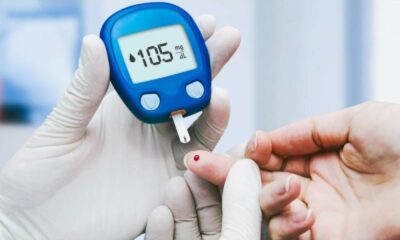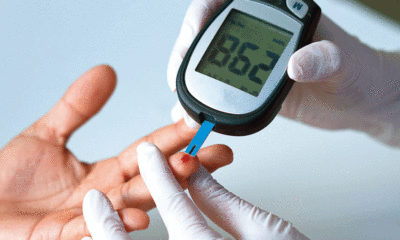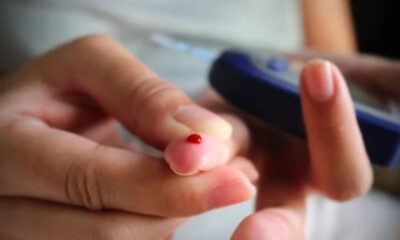Diabetology
What Is The Best Exercise For Diabetes?
Published
1 year agoon
By
Robert
There isn’t a single “best” exercise for diabetes, but rather a fantastic combination of approaches that tackle different aspects of blood sugar control and overall well-being. This guide dives into the wonderful world of exercise for diabetes management, exploring various options, their benefits, and tips to create a personalized exercise routine.
Unveiling the Champions: Aerobic vs. Strength Training
Aerobic Exercise (Cardio): The heart of diabetic exercise, cardio gets your blood pumping and muscles working, improving insulin sensitivity and aiding blood sugar control. Here are some champions:
- Walking: The king of accessibility, walking is a low-impact, free activity you can do almost anywhere. Aim for a brisk 30-minute walk most days of the week.
- Swimming: A gentle giant on joints, swimming provides a full-body workout while keeping you cool. It’s perfect for those with joint pain or neuropathy.
- Cycling: Indoor cycling or cruising outdoors is a fantastic low-impact exercise for strengthening legs and improving cardiovascular health.
Strength Training: Building muscle mass is crucial for diabetics. Muscles act like sugar sponges, soaking up glucose from the bloodstream. Here are some contenders:
- Weightlifting: Don’t be intimidated! Weightlifting can be done with dumbbells, resistance bands, or even bodyweight exercises like squats and lunges. Start light and gradually increase weight or difficulty.
- Yoga: This mind-body practice combines strength training with flexibility and balance work. Yoga can also improve stress management, which can indirectly benefit blood sugar control.
The Dynamic Duo: Combining both aerobic and strength training offers the most comprehensive benefits. You can alternate days dedicated to each type of exercise or incorporate them into a single session.
Beyond the Champions: Exploring Diverse Activities
- Dancing: Salsa your way to better blood sugar! Dancing is a fun, social way to get your heart rate up and improve coordination.
- Team Sports: Basketball, soccer, or badminton – anything that gets you moving and working together is a win. Team sports provide a social element and extra motivation.
- Tai Chi: This low-impact exercise combines gentle movements with deep breathing, promoting relaxation and balance. It’s a great option for those new to exercise or with limited mobility.
Remember: Listen to your body. Start slowly and gradually increase intensity and duration as your fitness improves.
Individualized Exercise Plans: Crafting Your Routine
Here’s how to design your personalized exercise regimen:
- Consult your doctor: Discuss your current health status, fitness level, and any limitations before starting a new exercise program.
- Consider your preferences: Choose activities you enjoy! This will make exercise feel less like a chore and more like a fun way to spend time.
- Start slow and progress gradually: Begin with shorter durations and lower intensities, and gradually increase them over time to avoid injuries.
- Find an exercise buddy: Having a partner can boost motivation and make exercise more social.
- Set realistic goals: Start small and celebrate your achievements!
Bonus Tips: Keeping the Exercise Flame Alive
- Track your progress: Monitor your blood sugar levels before and after exercise, and keep a log of your workouts to stay motivated.
- Make it convenient: Schedule your workouts in your calendar and keep your exercise clothes readily available.
- Break it down: If a 30-minute session feels daunting, break it down into smaller chunks throughout the day. Take the stairs, park further away, or do some stretches during commercial breaks.
- Reward yourself: Celebrate your exercise milestones with healthy rewards, like a new workout outfit or a relaxing massage.
Remember, consistency is key. Even moderate exercise most days of the week can significantly improve your blood sugar control and overall well-being. Embrace the power of movement, find activities you enjoy, and make exercise a cornerstone of your diabetes management plan.
While the core principles apply broadly, some diabetic conditions might require adjustments to your exercise routine. Here’s a closer look:
Diabetic Neuropathy: This nerve damage can cause pain, numbness, and tingling in the feet and legs. Low-impact exercises like swimming, water aerobics, or cycling are great options. Ensure proper footwear and inspect your feet for injuries after exercise.
Diabetic Retinopathy: This eye condition necessitates caution with high-impact activities that could increase pressure on the eyes. Opt for moderate-intensity exercises like walking, swimming, or elliptical training.
Heart Disease: If you have diabetes and heart disease, getting clearance from your doctor is crucial. Start with low-impact exercises and gradually increase intensity as tolerated. Consider cardiac rehabilitation programs designed for individuals with heart conditions.
For Individuals with Limited Mobility: Chair exercises, resistance band workouts, or gentle yoga modifications can be incredibly beneficial. Consult a certified fitness professional who can design a safe and effective program based on your limitations.
Blood Sugar Management and Exercise:
- Monitor Before, During, and After: Checking your blood sugar before, during (for long workouts), and after exercise helps you understand how your body reacts and adjust insulin intake accordingly.
- Carry Emergency Supplies: Always have glucose tablets or other quick-acting carbohydrates on hand to treat potential hypoglycemia (low blood sugar) during exercise.
- Stay Hydrated: Drink plenty of water before, during, and after exercise to prevent dehydration, which can worsen blood sugar control.
The Power of Exercise Beyond Blood Sugar
Exercise offers a treasure trove of benefits beyond just blood sugar control:
- Weight Management: Regular physical activity aids in weight management or loss, further improving insulin sensitivity.
- Improved Mood: Exercise is a natural mood booster, helping to combat stress, anxiety, and depression, common companions of diabetes.
- Stronger Bones and Muscles: Strength training builds muscle mass and bone density, reducing the risk of osteoporosis, a common complication in diabetics.
- Better Sleep: Regular exercise promotes better sleep quality, which in turn can improve blood sugar control.
- Enhanced Energy Levels: Exercise increases your body’s efficiency in using oxygen, leading to improved energy levels throughout the day.
Conclusion
Exercise is a powerful tool for managing diabetes and promoting overall well-being. Explore different activities, find what you enjoy, and make movement a part of your daily routine. Remember, consistency is key. With dedication and the right approach, you can unlock the power of exercise and live a healthier, happier life with diabetes.
You may like
-


Essential Lifestyle Tips for Preventing Diabetes Complications
-


Stress Management Emerging as Essential Part of Diabetes Care
-


Smart Strategies for Controlling Blood Sugar Naturally
-


Plant-Based Diet Linked to Blood Sugar Benefits, But Less Than Mediterranean Diet
-


Daily Habits to Improve Your Fasting Blood Sugar
-


Daily Tips for Healthy Blood Sugar Control for Beginners
The Latest News
- Best Lifestyle Changes to Lower Stress and Balance Blood Sugar Naturally
- Best Morning Routine for Diabetics: A Complete Guide
- Diabetes Management: Effective Strategies to Control Blood Sugar Naturally
- Best Morning Routines for People with Diabetes
- Essential Lifestyle Tips for Preventing Diabetes Complications
- Diabetes Awareness in Children: Early Habits That Matter
- Importance of Regular Blood Sugar Monitoring

Best Lifestyle Changes to Lower Stress and Balance Blood Sugar Naturally

Best Morning Routine for Diabetics: A Complete Guide

Diabetes Management: Effective Strategies to Control Blood Sugar Naturally

Lung growth invading Treg have different transcriptional profiles and capability connected to designated spot bar reaction

Psoriasis be treatment by adjuvant Salicylic acid, ceramides as this containing lotions

